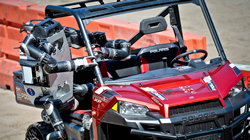Why Robots and Humans Struggled with DARPA's Challenge
 Will Knight for MIT Technology Review: When some of the world’s most advanced rescue robots are foiled by nothing more complex than a doorknob, you get a good sense of the challenge of making our homes and workplaces more automated.
Will Knight for MIT Technology Review: When some of the world’s most advanced rescue robots are foiled by nothing more complex than a doorknob, you get a good sense of the challenge of making our homes and workplaces more automated.At the DARPA Robotics Challenge, a contest held over the weekend in California, two dozen extremely sophisticated robots did their best to perform a series of tasks on an outdoor course, including turning a valve, climbing some steps, and opening a door (see “A Transformer Wins DARPA’s $2 Million Robotics Challenge”). Although a couple of robots managed to complete the course, others grasped thin air, walked into walls, or simply toppled over as if overcome with the sheer impossibility of it all. At the same time, efforts by human controllers to help the robots through their tasks may offer clues as to how human-machine collaboration could be deployed in various other settings.
“I think this is an opportunity for everybody to see how hard robotics really is,” says Mark Raibert, founder of Boston Dynamics, now owned by Google, which produced an extremely sophisticated humanoid robot called Atlas. Cont'd...
Featured Product

New incremental encoder IERF3 L from FAULHABER
FAULHABER is expanding its product range with the ultra-precise incremental encoder IERF3 L. Thanks to the optical measuring principle and state-of-the-art chip technology, the device offers the highest resolution, excellent repeatability, and outstanding signal quality. In typical applications, the positioning accuracy is 0.1° and the repeatability 0.007°. This makes the encoder the perfect solution for high-precision positioning applications in confined spaces.
